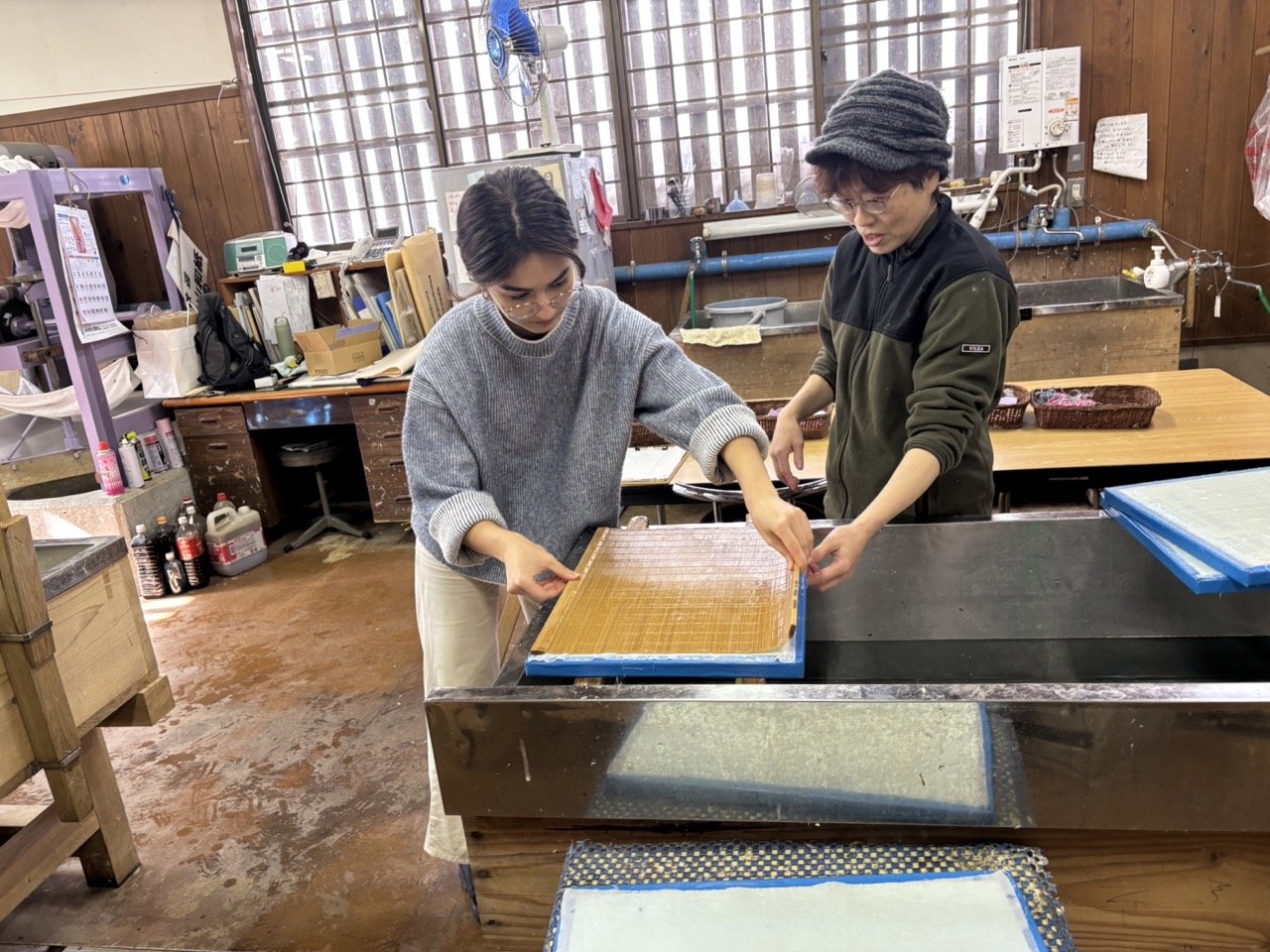Japanese conservation techniques part 2 - A Journey into the Traditional Japanese Craft of Washi Paper Making
Frame’s Leina Taylor making washi paper in Yamagata, Japan.
In the second instalment of our Japanese conservation series, Frame London’s own Leina Taylor travels to the serene northern region of Japan, exploring the materials that shape our daily work at the forefront of conservation framing. Nestled at the foot of Mount Gassan lies a small papermaking studio, home to the craft of making Gassan washi—a traditional Japanese paper known for its strength, flexibility, and durability.
Leina’s journey took her inside a working papermaking studio, where artisans continue centuries-old techniques using raw materials including kōzo (paper mulberry), mistumata and gampi. These hands-on workshops offered not only a guided tour of the space but also the chance to form and couch sheets of washi by hand, experimenting with different thicknesses and gaining firsthand insight into the careful balance of skill and intuition behind each sheet.
At Frame London, Japanese papers like Gassan washi play an essential role in our conservation framing practice. We use them daily in the delicate mounting of works on paper—an area where precision, knowledge, and respect for materials are crucial. This trip was part of our ongoing research to remain at the forefront of conservation framing, ensuring we understand not just how to use these materials, but where they come from and why they matter.
In this post, Leina reflects on the rich history behind washi paper and shares why its legacy continues to influence and elevate our conservation work today.
Understanding Japanese Paper (Washi) in Conservation Framing
Japanese paper, known as washi (和紙), plays an essential role in conservation practices around the world. Revered for its purity, strength, and delicacy, washi is uniquely suited to the preservation of artworks. Its long fibres, lightweight nature, and lack of impurities make it an ideal material for delicate conservation work, offering flexibility and durability without introducing harmful substances that could degrade a piece over time.
What Makes Washi So Special?
The unique qualities of washi come from the traditional techniques and natural materials used in its production. Most washi is made from the inner bark of bast fibre plants—primarily kōzo (paper mulberry), mitsumata, and gampi. Of these, kōzo-based papers are particularly favoured in Western conservation circles due to their exceptional strength and translucency.
Common types of kōzo-based washi used in conservation include:
Tengujo – one of the thinnest handmade papers in the world
Misu – soft and pliable, ideal for repair work
Minogami – noted for its smooth surface and strength
Sekishu-shi – a robust and versatile paper from the Sekishu region
Udagami – known for its balanced texture and durability
The Traditional Papermaking Process
The process of making washi is as meticulous as it is beautiful. It begins with harvesting the stems of kōzo or other bast plants. These stems are steamed, and the outer bark is carefully removed by hand. The remaining fibres are then soaked and cooked in an alkaline solution, which helps remove impurities and break down non-cellulose components and to aid the overall softening and separation of fibres.
After cooking, the fibres are beaten to separate and loosen them further. The pulp is then mixed into a vat of water along with neri—a viscous extract made from the tororo aoi root (Abelmoschus Manihot). This natural additive helps the fibres remain suspended in water, allowing for even sheet formation and controlled drainage.
Forming the Sheets
Using bamboo screens called su (簀) fixed into wooden frames, artisans collect the pulp in layers, repeating the process to build up the desired paper thickness. This method, known as nagashizuki (流し漉き), involves skillfully shaking and layering the pulp so that water drains slowly, creating an even and strong sheet.
Once formed, the wet paper is couched—a technique where the fresh sheet is gently transferred onto a stack of previously formed papers by removing the screen and layering it directly. This precise and repetitive process continues until a full batch is ready for drying.
The FRAME London Approach: Using Japanese Paper in Conservation Framing
At FRAME London, our commitment to conservation framing is grounded in both tradition and precision, using washi paper as one of the key materials we rely on every day—used to hinge mount every work on paper that comes through our studio.
Whether we’re preparing contemporary prints, restoring historical documents, or preserving cherished personal artworks, Japanese washi is at the heart of our process. When paired with wheat starch paste—another time-tested, reversible adhesive—it offers unmatched strength, flexibility, and stability. These qualities make it ideal for conservation purposes, allowing artworks to be secured safely without compromising their integrity or future restorability.
Our approach is informed by a deep respect for the materials we use. By continually studying the traditional techniques and cultural heritage behind washi production, we ensure our framing practices remain at the highest level. This ongoing research enhances not only our technical expertise but also the care we offer every client.
In our North London studio, every artwork is treated with the utmost respect. With Japanese paper as a cornerstone of our process, our clients can trust that their pieces are preserved with longevity in mind, and handled with craftsmanship that honours both past and present.







